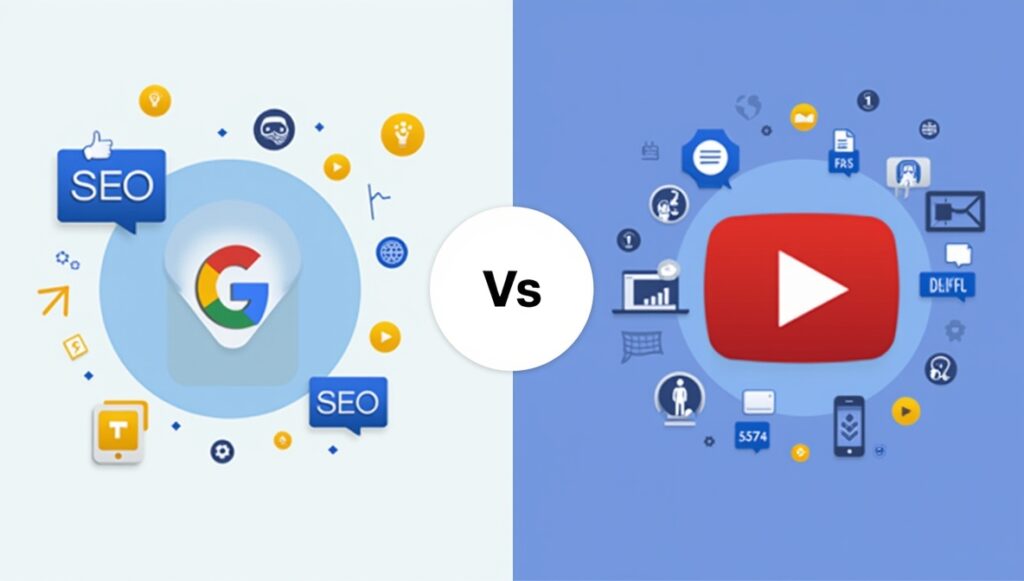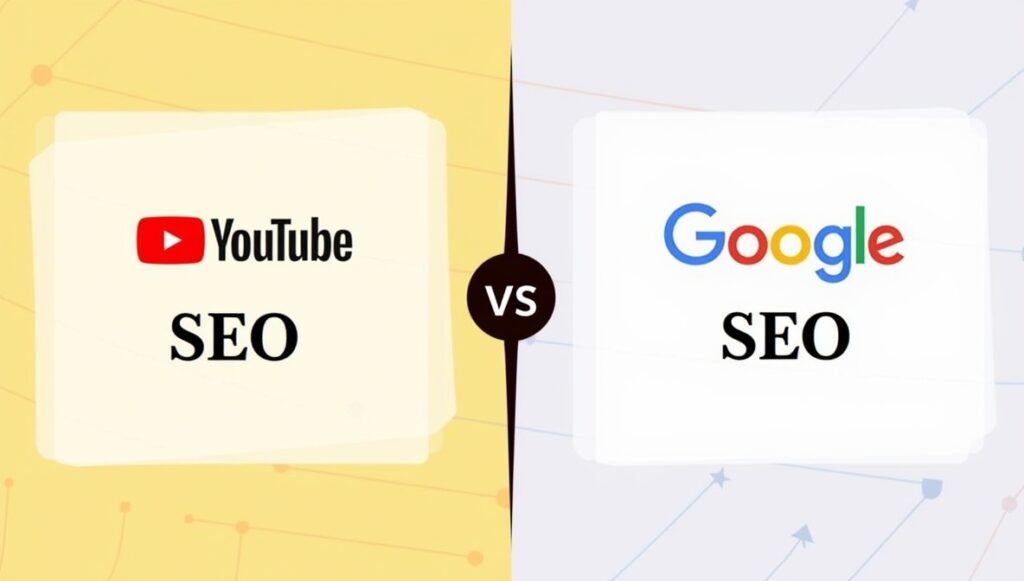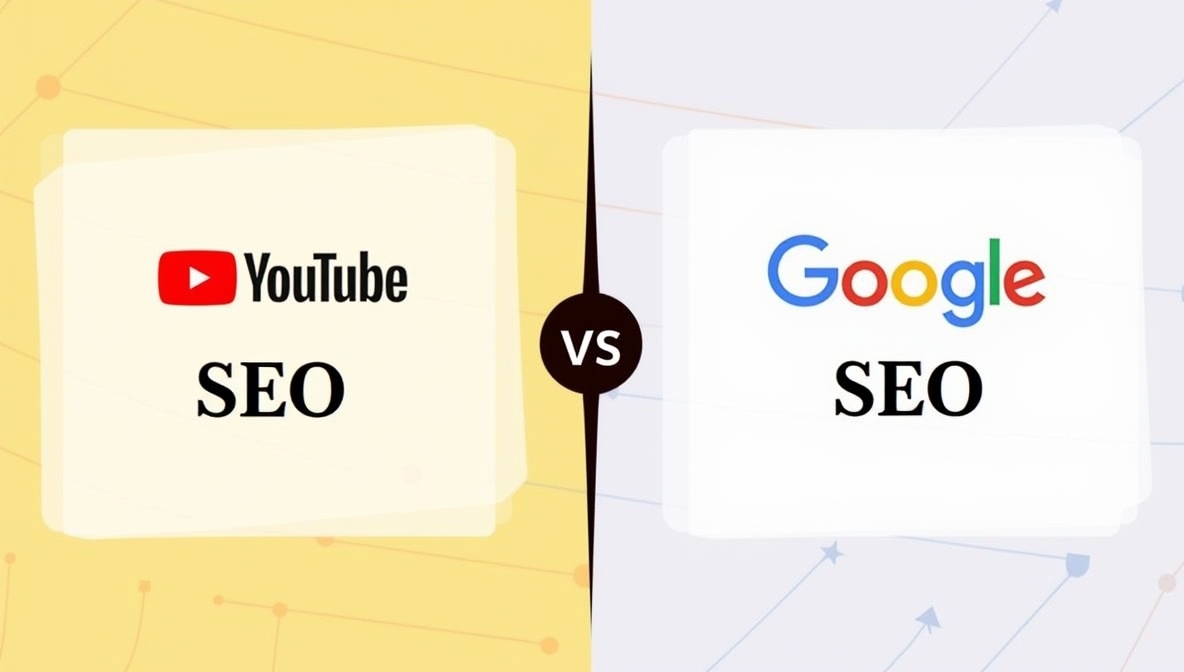
In the world of digital marketing, search engine optimization, search engine optimization (SEO, search engine optimization (SEO) is essential to ensuring visibility, engagement, and conversions. When most people hear “SEO,” they think of Google — the world’s leading search engine. However, another powerful platform has emerged as a critical player in search engine optimization: YouTube. While both Google SEO and YouTube SEO are vital components of a comprehensive digital marketing strategy, understanding the differences between the two can help businesses optimize their content effectively and reach their target audience.
So, how does YouTube SEO differ from Google SEO? And which one should you focus on? In this article, we will explore the distinctions and overlaps between YouTube SEO and Google SEO, giving you actionable insights to enhance your overall SEO strategy.
What is Google SEO?

Google SEO refers to the practice of optimizing your website and its content to rank higher in Google’s search engine results pages (SERPs). As Google dominates the search engine market, it remains the primary focus for businesses looking to increase website traffic and visibility. Google SEO includes several components:
- On-Page SEO: Optimizing elements like meta titles, meta descriptions, header tags, and keyword usage within your website’s content.
- Off-Page SEO: Building backlinks from other reputable websites to improve your site’s authority.
- Technical SEO: Ensuring your website has fast loading speeds, mobile responsiveness, secure HTTPS encryption, and proper indexing by search engines.
- Content Optimization: Publishing high-quality, relevant, and keyword-optimized content that aligns with users’ search intent.
- Local SEO: Targeting geographic-specific searches to attract local audiences.
Google SEO operates primarily through algorithms that prioritize relevance, authority, and user experience. Success on Google’s SERPs can result in increased organic traffic, improved credibility, and better business outcomes.
What is YouTube SEO?
YouTube SEO, on the other hand, focuses on optimizing video content to rank higher in YouTube’s search engine results pages (SERPs). As the second largest search engine and the go-to platform for video content, YouTube offers unique opportunities for creators and businesses alike. Key aspects of YouTube SEO include:
- Video Metadata: Optimizing video titles, descriptions, and tags with relevant keywords.
- Thumbnails: Designing eye-catching and relevant thumbnails to attract clicks.
- Engagement Metrics: Encouraging likes, comments, shares, and subscriptions, as YouTube’s algorithm heavily considers user engagement.
- Watch Time: Creating high-quality, engaging videos that retain viewers for longer periods.
- Video Transcripts: Including transcripts or closed captions to make videos accessible and help with keyword indexing.
- Playlists: Organizing related videos into playlists to increase watch time and user satisfaction.
YouTube SEO differs from Google SEO in that it is video-focused and places significant emphasis on user engagement metrics. Moreover, YouTube’s algorithm also considers personalization, meaning recommendations are tailored to individual users’ viewing habits.
Google SEO vs YouTube SEO: The Key Differences
While both Google and YouTube SEO share the ultimate goal of increasing visibility and driving traffic, they operate on fundamentally different platforms and cater to different types of content. However, there are some key differences between the two:
- Platform: Google SEO is focused on improving the ranking of a website on Google’s search engine results pages (SERPs), while YouTube SEO is focused on improving the ranking of videos on YouTube’s search engine results pages (SERPs).
Let’s break down some of the most significant differences:
1. Search Intent
- Google SEO: Users searching on Google are typically looking for a wide variety of content, including text-based articles, product pages, service pages, images, and videos. The search intent can be informational, transactional, or navigational.
- YouTube SEO: Users on YouTube are primarily seeking video content. They are often looking for tutorials, reviews, entertainment, or explanations in a visual format.
2. Content Format
- Google SEO: Prioritizes written content, such as blog posts, landing pages, and infographics, alongside other types of content like images and videos.
- YouTube SEO: Exclusively focuses on video content, requiring creators to produce visually engaging and high-quality videos to attract and retain viewers.
3. Ranking Factors
- Google SEO: Relies heavily on keyword relevance, content quality, backlinks, website speed, mobile-friendliness, and user behavior metrics (e.g., bounce rate, dwell time).
- YouTube SEO: Focuses on video-specific metrics such as watch time, audience retention, engagement (likes, comments, shares), and click-through rate (CTR) from thumbnails.
4. Algorithm Differences
- Google’s Algorithm: Utilizes a highly complex system that incorporates over 200 factors, including backlinks, content quality, and user experience.
- YouTube’s Algorithm: Prioritizes user engagement metrics, watch time, and personalization based on users’ viewing histories.
5. Search Results Appearance
- Google SEO: Search results may include organic links, paid ads, featured snippets, image packs, and video results.
- YouTube SEO: Search results typically display video thumbnails along with titles, descriptions, and channel names.
Why Both Google SEO and YouTube SEO Matter
In today’s digital landscape, focusing on both Google SEO and YouTube SEO can provide a comprehensive strategy to dominate the search ecosystem. Here’s why:
- Broader Reach: Combining Google’s text-based searches with YouTube’s video platform ensures your content reaches different audience segments.
- Cross-Promotion Opportunities: Videos optimized for YouTube can appear in Google’s search results, providing additional exposure and driving traffic to your website.
- Diverse Content Consumption: Some users prefer reading articles, while others prefer watching videos. Leveraging both platforms caters to diverse preferences.
- Authority and Credibility: A strong presence on both platforms establishes your brand as an authority in your industry, improving trust and engagement.
Tips for Optimizing YouTube SEO and Google SEO
Optimizing for Google SEO:
- Conduct thorough keyword research using tools like Google Keyword Planner or SEMrush.
- Create high-quality, user-focused content that matches search intent.
- Build backlinks from reputable websites to improve domain authority.
- Ensure your website is mobile-friendly and has fast loading speeds.
- Optimize meta tags and headers with relevant keywords.
Optimizing for YouTube SEO:
- Use YouTube-specific keyword tools like TubeBuddy or VidIQ to identify popular video keywords.
- Craft compelling video titles and descriptions with primary keywords.
- Create custom thumbnails to increase click-through rates.
- Encourage viewer engagement by asking for likes, comments, and subscriptions.
- Use YouTube Analytics to track performance and refine your strategy.
Choosing the Right Focus for Your Business
Should your business prioritize YouTube SEO or Google SEO? The answer depends on your target audience, content strategy, and overall marketing goals. If your audience consumes a significant amount of video content, investing in YouTube SEO can yield excellent results. Conversely, if your goal is to drive traffic to a website or blog, Google SEO should be your priority.
For many businesses, the ideal approach is to leverage both platforms. By repurposing content across Google and YouTube, you can maximize your visibility and reach. For example, you can create a blog post for Google and a corresponding video for YouTube, using both to complement each other.
Final Thoughts

YouTube SEO and Google SEO are both indispensable tools in the digital marketer’s arsenal. While they share similarities in terms of goals and strategies, the key differences between the two lie in the platforms, content formats, and ranking factors. By understanding these distinctions and implementing tailored strategies, businesses can effectively tap into the immense potential of both Google and YouTube, driving traffic, engagement, and conversions.
Whether you’re focusing on Google, YouTube, or both, an experienced digital marketing partner like Dust Digital Marketing Ltd. can help you navigate the complexities of SEO and achieve outstanding results. Visit our website at dusthk.com to learn more about our expert SEO services and how we can help your business grow.

